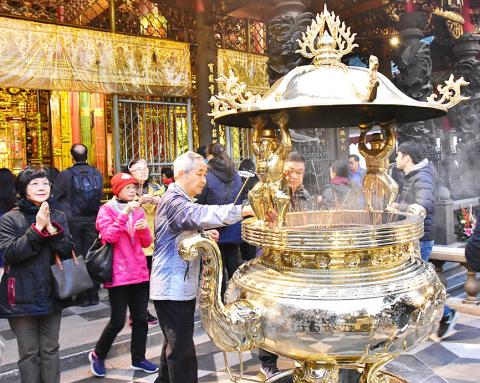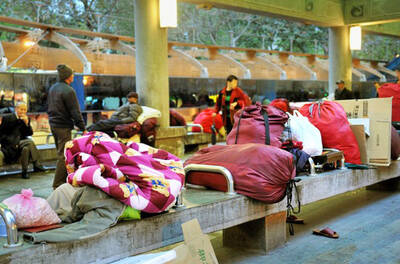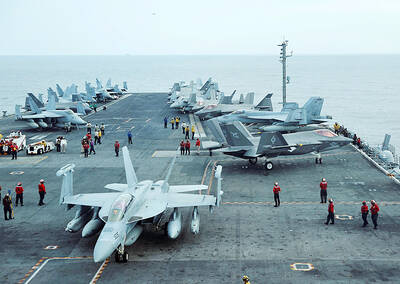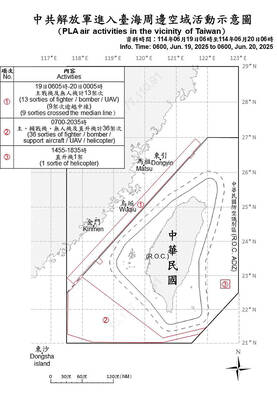Longshan Temple, one of Taipei’s most popular places of worship, has decided to limit the number of incense sticks worshipers can burn to one stick starting on May 5 in an effort to curb PM2.5 particulates.
The burning of incense releases PM2.5 pollutants — fine particulate matter measuring 2.5 micrometers or smaller in diameter — and other possibly carcinogenic materials into the air, and temple authorities have decided to limit the number of incense sticks that an individual can burn to one, Longshan Temple vice chairman Huang Shu-wei (黃書瑋) said.
Huang said the temple would inform worshipers of the new policy, and encourage them to go around the temple and worship all the gods and goddesses before placing their incense stick in an incense burner at the end of their tour of worship.

Photo: Chang I-chen, Taipei Times
The temple also plans to cut the number of incense burners at the temple from three to one, Huang said.
Worshipers tend to burn many incense sticks at the temple, placing them in incense burners along the way.
Huang said that since the temple first cut the number of incense burners from seven to three in 2015, many people have begun to “worship with their hearts” instead of burning incense to show support for the temple’s move, and the temple would now encourage this environmentally friendly practice.
The concentration of PM2.5 particulates remained high even after the reduction in the number of incense burners, especially on the first and the 15th day of each lunar month, and Huang said the temple considered removing all the incense burners at one point, but it aborted the plan after many worshipers implored temple authorities to keep at least one incense burner on the premises.
Asked if the temple would eventually remove all the incense burners, Huang said it would decide after seeing if the concentrations of PM2.5 improve.

A year-long renovation of Taipei’s Bangka Park (艋舺公園) began yesterday, as city workers fenced off the site and cleared out belongings left by homeless residents who had been living there. Despite protests from displaced residents, a city official defended the government’s relocation efforts, saying transitional housing has been offered. The renovation of the park in Taipei’s Wanhua District (萬華), near Longshan Temple (龍山寺), began at 9am yesterday, as about 20 homeless people packed their belongings and left after being asked to move by city personnel. Among them was a 90-year-old woman surnamed Wang (王), who last week said that she had no plans

TO BE APPEALED: The environment ministry said coal reduction goals had to be reached within two months, which was against the principle of legitimate expectation The Taipei High Administrative Court on Thursday ruled in favor of the Taichung Environmental Protection Bureau in its administrative litigation against the Ministry of Environment for the rescission of a NT$18 million fine (US$609,570) imposed by the bureau on the Taichung Power Plant in 2019 for alleged excess coal power generation. The bureau in November 2019 revised what it said was a “slip of the pen” in the text of the operating permit granted to the plant — which is run by Taiwan Power Co (Taipower) — in October 2017. The permit originally read: “reduce coal use by 40 percent from Jan.

China might accelerate its strategic actions toward Taiwan, the South China Sea and across the first island chain, after the US officially entered a military conflict with Iran, as Beijing would perceive Washington as incapable of fighting a two-front war, a military expert said yesterday. The US’ ongoing conflict with Iran is not merely an act of retaliation or a “delaying tactic,” but a strategic military campaign aimed at dismantling Tehran’s nuclear capabilities and reshaping the regional order in the Middle East, said National Defense University distinguished adjunct lecturer Holmes Liao (廖宏祥), former McDonnell Douglas Aerospace representative in Taiwan. If

‘SPEY’ REACTION: Beijing said its Eastern Theater Command ‘organized troops to monitor and guard the entire process’ of a Taiwan Strait transit China sent 74 warplanes toward Taiwan between late Thursday and early yesterday, 61 of which crossed the median line in the Taiwan Strait. It was not clear why so many planes were scrambled, said the Ministry of National Defense, which tabulated the flights. The aircraft were sent in two separate tranches, the ministry said. The Ministry of Foreign Affairs on Thursday “confirmed and welcomed” a transit by the British Royal Navy’s HMS Spey, a River-class offshore patrol vessel, through the Taiwan Strait a day earlier. The ship’s transit “once again [reaffirmed the Strait’s] status as international waters,” the foreign ministry said. “Such transits by